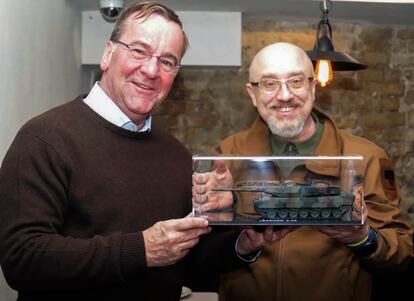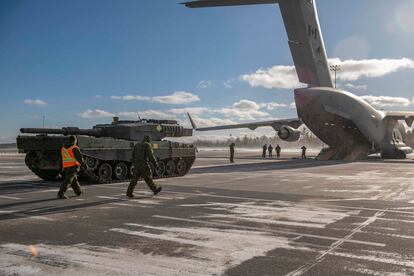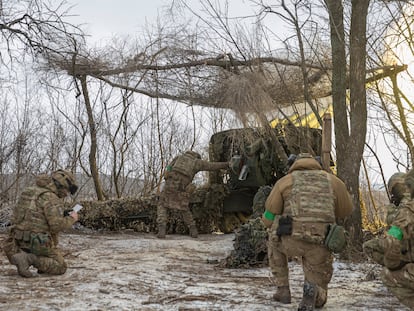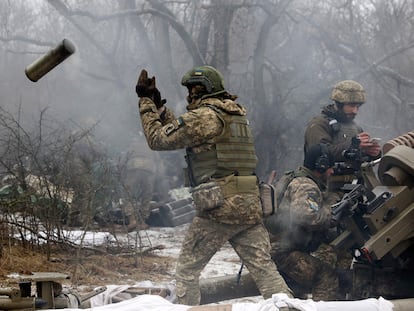As Kyiv’s allies drag feet over Leopard 2 deliveries, Berlin starts restoring older models
Germany, Denmark and the Netherlands have formed a coalition to refit 100 Leopard 1 tanks that have been in storage for decades to send to Ukraine


A NATO coalition to provide Leopard tanks to Ukraine has been set in motion, but it is not moving at the pace that Berlin would like. Two weeks ago, German Chancellor Olaf Scholz turned the West’s policy on sending heavy weapons to Ukraine on its head when he announced the delivery of 14 Leopard 2 battle tanks, and gave authorization for other countries who have the heavy armor in their arsenals to do likewise. After months of pressure from Kyiv and NATO allies including Poland and the Baltic states, Berlin finally relented after persuading the United States to follow suit by agreeing to send 31 Abrams tanks to Ukraine. Since then, the German government has been trying to piece together the two armored battalions that were promised, but many of the countries in the coalition have yet to make a firm commitment in terms of the number of tanks they are willing to provide.
Berlin dragged its feet for months over the decision to provide heavy armor, but now that the line has been crossed it is leading efforts to ensure delivery. German Defense Minister Boris Pistorius has already convened several video meetings with countries in possession of Leopard 2 units and has expedited re-export permits - necessary because the tanks are German-made and can only be resold or transferred with the express permission of Berlin.
However, the delay among Kyiv’s allies in providing figures over the number of Leopard 2s they are willing to deliver has led Germany to turn its attention to the older Leopard 1 model. While waiting for countries including Norway, Portugal and Spain to decide how many of the most modern tanks in Europe they can provide, Germany is turning to the previous generation of Leopards, manufactured between 1965 and 1985 with various upgrades. For the time being, Berlin has authorized the export to Ukraine of 178 Leopard 1s, many of which have been in storage for decades, and which the military industry is in the process of fitting out.
Other countries have proven far more willing to commit Leopard 1 tanks to Ukraine. The defense ministries of Germany, Denmark and the Netherlands announced Tuesday that between them they will send Kyiv a minimum of 100 units of the Leopard 1A5, which was developed in the early 1980s. All of these will come from industrial stocks and will have to be overhauled because they have been inactive for a considerable period of time. Some of these will be ready for delivery in a few months and most can be operational on the front lines in 2024. The partnership includes the training of Ukrainian troops, “logistical support, spare parts and an ammunition package,” said the joint statement signed by the three countries, which could be joined by Belgium.
Berlin to push for commitment
In the meantime, the German Chancellery is trying to persuade its European neighbors to commit to the delivery of Leopard 2 tanks, which are better armored than the Leopard 1 and carry more firepower. According to Der Spiegel, the lack of firm commitments has prompted Scholz to get personally involved in the negotiations, to the point of calling the coalition heads of government one by one. The current reticence in some coalition countries - precisely those that were most vociferous in demanding Berlin’s participation - has caused astonishment and no small amount of displeasure within the German government.
Without explicitly mentioning a particular country or the Leopards, Scholz on Wednesday reproached what he described as a “public competition” to see who can send more weapons to Ukraine. In an intervention in the Bundestag prior to an EU summit this Thursday and Friday in Brussels, Scholz noted that criticism between the allies only works to the benefit of Russian President Vladimir Putin, who could view such disputes as displaying a lack of union among Kyiv’s backers. The Social Democrat called for greater “cohesion,” both within his own government coalition - his Green and Liberal partners also pressured him to agree to send the Leopards - and among the Western allies.

First Leopard 2 tank delivered by Canada
While Scholz attempts to rally his European allies, the first Leopard 2 has been delivered to Ukraine from Canada. The first of four tanks initially promised by Justin Trudeau’s government took off Saturday from Halifax and landed a few hours later at an undisclosed point in Poland, from where it will cross the border where trained crews are in place to begin deployment in Ukraine.
As things stand, Leopard 2 commitments are insufficient to form the two battalions Germany wanted to assemble. Berlin has offered 14 Leopard 2 A6 battle tanks from German Army stocks and intends to have them on the ground by the end of March, Pistorius announced during his visit to Kyiv. However, the minister no longer spoke of “two battalions,” as Scholz had two weeks previously, but of “one or two battalions,” a clear indication that expectations over the delivery of Leopard 2s have been lowered.
Poland has committed to send 14 Leopard 2 A4 tanks. Norway, Portugal and Spain have not yet announced how many they will contribute, although it is estimated that each country will provide fewer than 10 each. Spanish government sources have told EL PAÍS that the Madrid shipment would initially consist of between four and six units. Finland, Denmark, the Netherlands and Sweden have also yet to confirm their level of participation regarding the more modern tanks. Denmark and the Netherlands joined the Leopard 1 coalition before signing up for the Leopard 2 agreement and they are expected to contribute funds for their purchase and tuning rather than sending tanks from their own arsenals.
Criticism over the delays in providing Ukraine with modern Western-made tanks has been constant and in Germany Scholz continues to be blamed for lost time when intelligence reports point to an imminent Russian offensive. “All the decisions he has been taking, preserving the principle of not becoming part of a war, of not acting alone, he could have taken six months ago,” retired brigadier general Klaus Wittmann said Wednesday during a meeting with foreign correspondents in Berlin.
German military industry companies have already set to work to refurbish tanks that, in some cases, are over 40 years old. A company in the north of the country, Flensburger Fahrzeugbau Gesellschaft, will refit 90 units that have been in storage for decades. A second group of tanks will arrive from Italy, which has 88 Leopard 1s in storage. Arms manufacturer Rheinmetall AG is now going to buy them back, transfer them to its plants in Germany and modernize them. According to Pistorius, the first 20 to 25 Leopard 1 tanks will arrive in Ukraine before the summer.
Sign up for our weekly newsletter to get more English-language news coverage from EL PAÍS USA Edition
Tu suscripción se está usando en otro dispositivo
¿Quieres añadir otro usuario a tu suscripción?
Si continúas leyendo en este dispositivo, no se podrá leer en el otro.
FlechaTu suscripción se está usando en otro dispositivo y solo puedes acceder a EL PAÍS desde un dispositivo a la vez.
Si quieres compartir tu cuenta, cambia tu suscripción a la modalidad Premium, así podrás añadir otro usuario. Cada uno accederá con su propia cuenta de email, lo que os permitirá personalizar vuestra experiencia en EL PAÍS.
¿Tienes una suscripción de empresa? Accede aquí para contratar más cuentas.
En el caso de no saber quién está usando tu cuenta, te recomendamos cambiar tu contraseña aquí.
Si decides continuar compartiendo tu cuenta, este mensaje se mostrará en tu dispositivo y en el de la otra persona que está usando tu cuenta de forma indefinida, afectando a tu experiencia de lectura. Puedes consultar aquí los términos y condiciones de la suscripción digital.
More information
Archived In
Últimas noticias
Most viewed
- Reinhard Genzel, Nobel laureate in physics: ‘One-minute videos will never give you the truth’
- Oona Chaplin: ‘I told James Cameron that I was living in a treehouse and starting a permaculture project with a friend’
- Pablo Escobar’s hippos: A serious environmental problem, 40 years on
- Chevy Chase, the beloved comedian who was a monster off camera: ‘Not everyone hated him, just the people who’ve worked with him’
- Why we lost the habit of sleeping in two segments and how that changed our sense of time










































